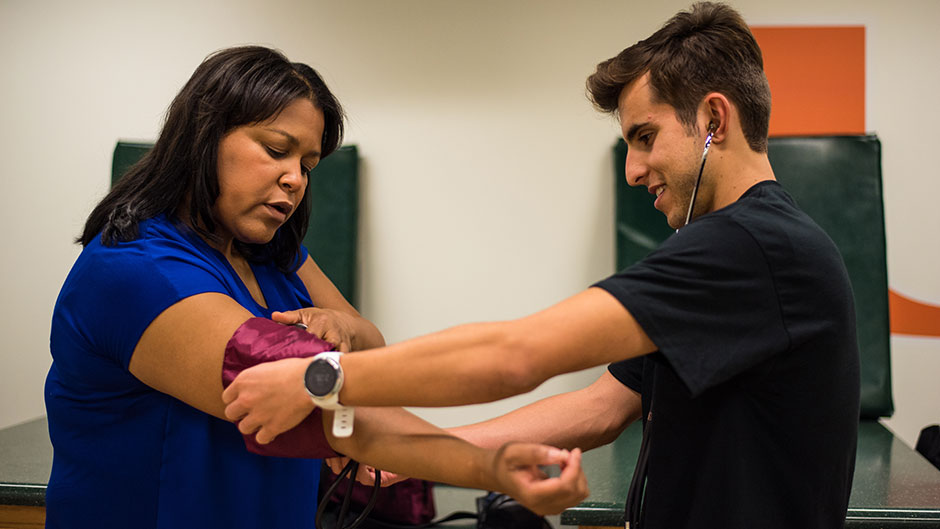For more than 20 years, Kysha Harriell has worked diligently to bring more ethnic diversity to the athletic training profession. She has introduced high school students to the University of Miami program, recruited talented undergraduates, and traveled throughout the Southeast as a volunteer for the National Athletic Trainers Association (NATA) building awareness of her profession.
Now, Harriell, associate clinical professor and director of the Athletic Training Program in the Department of Kinesiology and Sport Sciences, has been recognized for her volunteer efforts with the 2019 National Athletic Trainers’ Association Service Award, which recognizes her leadership in NATA’s outreach and community service programs. She will receive in June at the association’s annual conference.
“Kysha Harriell’s commitment to her students, the University of Miami and the profession of athletic training are beyond impressive,” said Karen Lew Feirman, an adjunct faculty member at the University of West Florida, who nominated her for the NATA service award. “There is not a person in this world that takes more care and shows concern for her students, staff, patients, and the profession of athletic training. “
A Leader in NATA
Harriell serves as chair of NATA’s Ethnic Diversity Advisory Committee, which promotes the profession and looks at issues that may affect the health of minority athletes, such as sickle cell anemia, hypertension (high blood pressure) and other chronic health problems.
“Today, only about 4 percent of athletic trainers are black or Hispanic,” Harriell said. “One reason the numbers are small is that many young people are simply not aware of our field. They follow their favorite sports teams, but don’t realize that there are many other opportunities for rewarding careers related to sports.”
In February 2018, Harriell led a NATA health fair at the training center of the New Orleans Saints, hosting 300 minority students under age 12. “They learned about CPR techniques, as well as the importance of sleep, nutrition, and regular exercise for physical wellbeing,” she said.
While in New Orleans, Harriell was invited to participate in an ESPN sports radio talk show to talk about her profession. “I believe it’s important for minority children to see athletic trainers, professors, doctors, and other professionals who look like them,” she said. “You don’t have to be a super-star athlete to play an important role in the playing field or indoor court.”
A Diverse AT Program
Thanks to its longstanding commitment to diversity and inclusion, the School of Education and Human Development has one of the most diverse athletic training faculty in the U.S., according to Harriell. “Our student diversity has also increased substantially in the past few years,” she added.
Currently, there are 44 undergraduates in the Athletic Training Program, including 18 juniors, the largest class in the school’s history. However, the last undergraduate class will start this fall, as the school shifts to a graduate program beginning in fall 2020. “That’s in keeping with a national initiative to move athletic training to a master’s level program,” Harriell said. “We plan to continue recruiting talented ethnically diverse graduate students, who may face financial challenges after paying for their undergraduate education.”
Every April, Harriell guides a UM student-run workshop for Miami-Dade high school students, who learn about CPR, and practice spine boarding and taping injuries as well as about the athletic training profession. “It gives our Athletic Training students an opportunity to showcase what they have learned,” she said. “We also invite high school athletic trainers to come on campus, where we provide continuing education credits for free. It’s one of the ways we give back to our community, and it’s great for recruiting as well. Several of our current students became interested in our field after attending a UM workshop as a high school student.”
Becoming an Athletic Trainer
Growing up in Washington, DC, Harriell was interested in sports at an early age. Her father enjoyed taking her to Washington Redskins games, and she remembers seeing Giants linebacker Lawrence Taylor tackle quarterback Joe Theismann, breaking his leg and ending his career in 1985. “I knew at that point I wanted to do something related to medicine to help athletes,” she said. “I like science and math, as well as sports, so athletic training was a great career choice for me.”
Harriell, who joined the University of Miami in 1998, says many young people don’t understand the role of athletic trainers. “We are sports medicine practitioners,” she said. “It’s like being a paramedic, a nurse, and physical therapist all wrapped into one. We see our patients every day from the time they are injured through the treatment and rehabilitation until they can get back into action. It’s a great profession, and it’s a pleasure to let others know about our field.”

